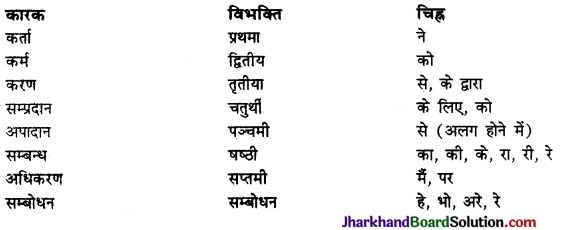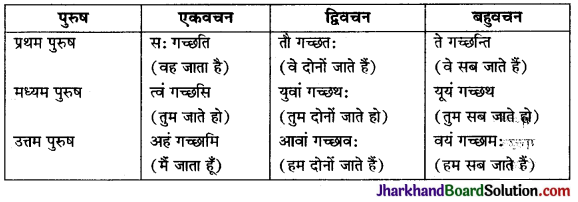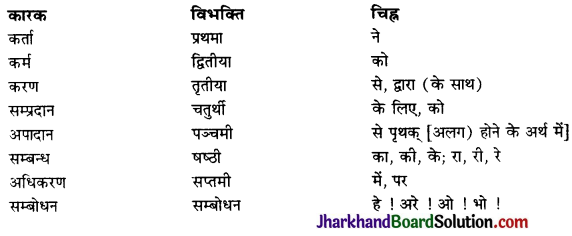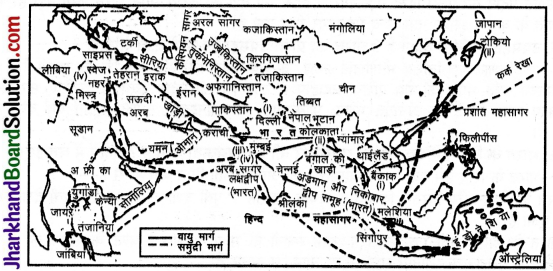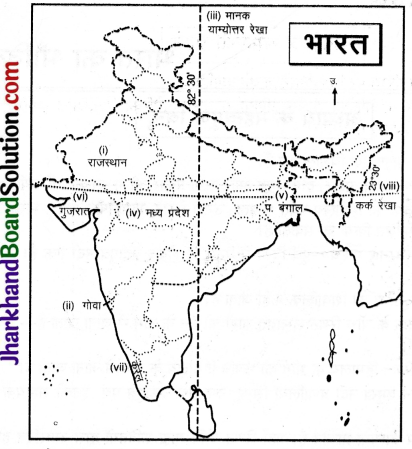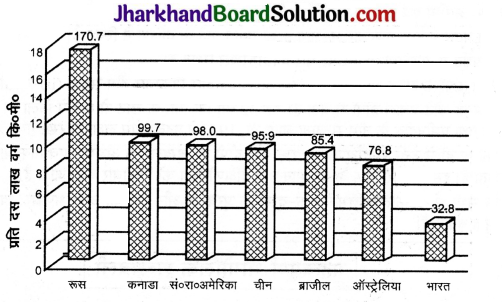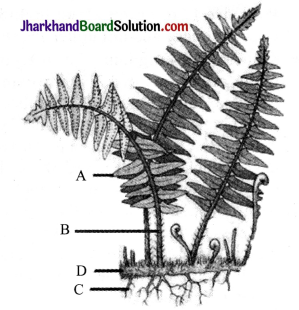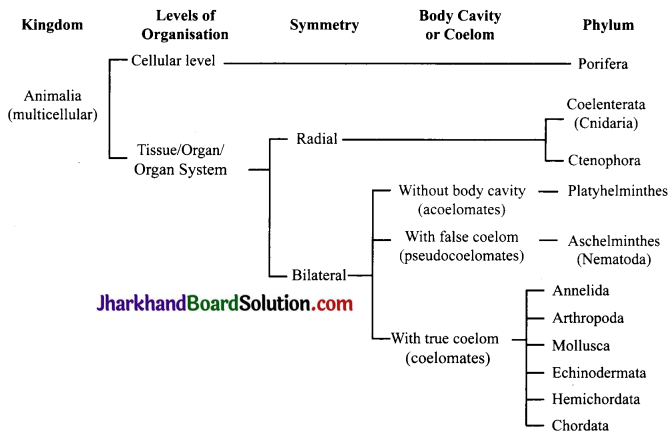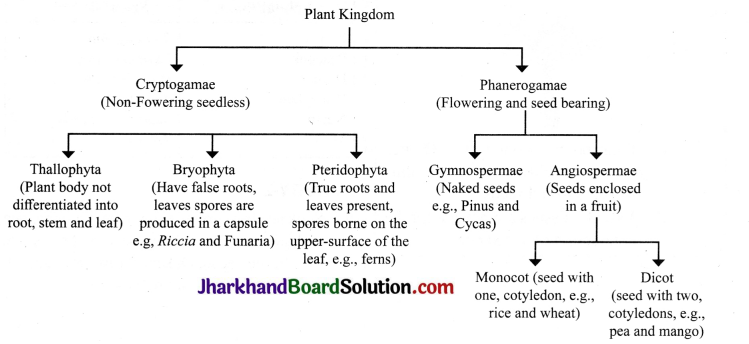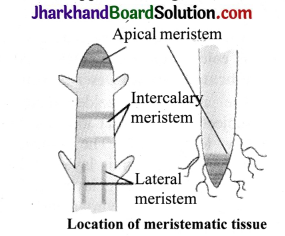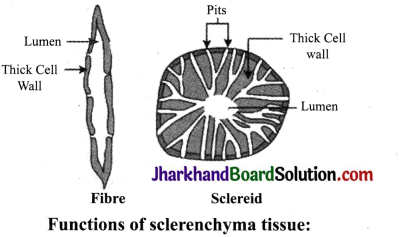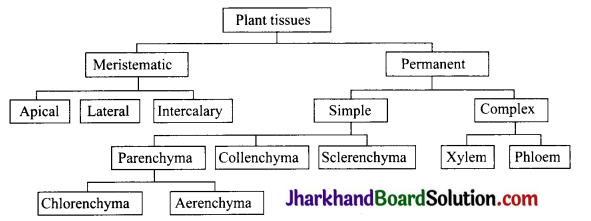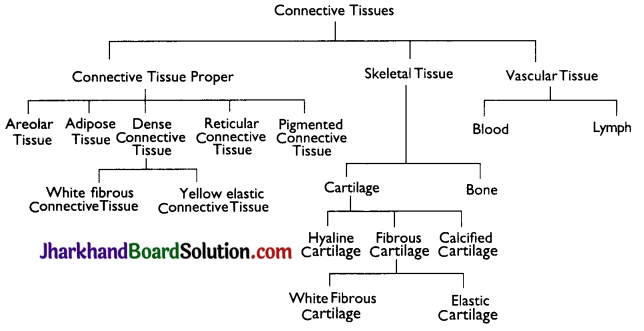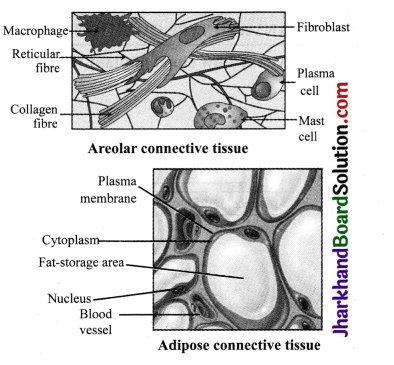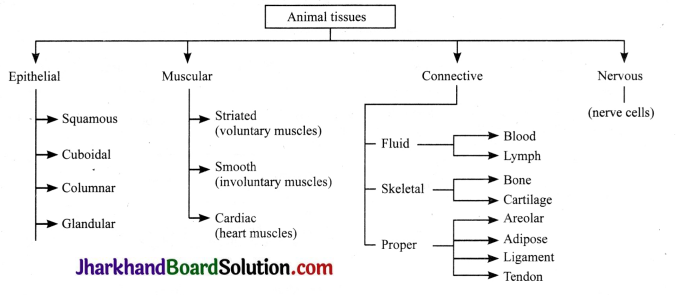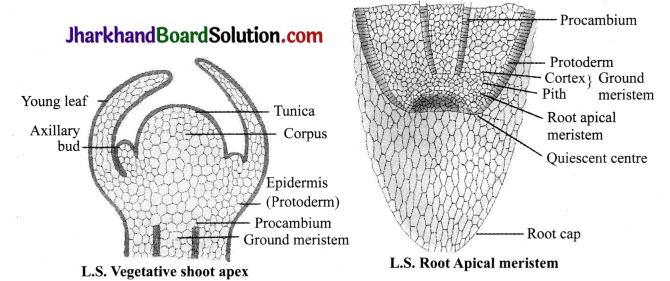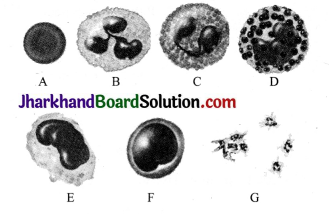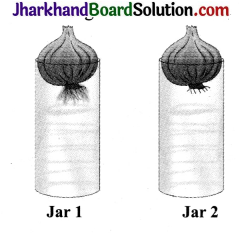Jharkhand Board JAC Class 10 Sanskrit Solutions रचना घटनाक्रमस्य संयोजनम् Questions and Answers, Notes Pdf.
JAC Board Class 10th Sanskrit Rachana घटनाक्रमस्य संयोजनम्
घटनाक्रमस्य संयोजनम् घटना
संस्कृतकथासाहित्यमतीव समृद्धम् अस्ति। अत्र नैकानां नीतिकथानां महान् संग्रहो वर्तते। तासु काश्चित्-प्रसिद्धाः कथाः अत्र क्रमरहितवाक्येषु अतिसंक्षिप्ततया लिखिताः। तानि कथा-वाक्यानि क्रमेण योजयित्वा कथाक्रमसंयोजनस्य पाठ्यक्रमानुरोधात् रचनात्मक-कौशल-विकासाय अभ्यासः करणीयः।
(संस्कृत कथा साहित्य अत्यन्त समृद्ध है। यहाँ एक ही नहीं, नीति कथाओं का महान संग्रह है, उनमें कुछ प्रसिद्ध कथा यहाँ क्रमरहित वाक्यों में अत्यन्त संक्षिप्त रूप से लिखी हुई हैं। उनको कथा वाक्यक्रम में जोड़कर कथाक्रम संयोजन का पाठ्यक्रम अनुरोध से रचनात्मक कौशल विकास के लिए अभ्यास करना चाहिए।)
![]()
1. क्रमरहितवाक्येषु कथा
1. घटे जलम् अल्पम् आसीत्।
2. तस्य मस्तिष्के एकः विचार: समागतः।
3. एकः पिपासितः काकः आसीत्।
4. सः पाषाणखण्डानि घटे अक्षिपत्, जलं च उपरि आगतम्।
5. सः वने एकं घटम् अपश्यत्।
6. जलं पीत्वा काकः ततः अगच्छत्।
कथाक्रमस्य-संयोजनम्
1. एकः पिपासितः काकः आसीत्। (एक कौआ प्यासा था।)
2. सः वने एकं घटम् अपश्यत्। (उसने वन में एक घड़ा देखा।)
3. घटे जलम् अल्पम् आसीत्। (घड़े में पानी थोड़ा था।)
4. तस्य मस्तिष्के एकः विचार: समागतः। (उसके मस्तिष्क में एक विचार आया।)
5. स: पाषाणखण्डानि घटे अक्षिपत्, जलं च उपरि आगतम्। (उसने पत्थरों के टुकड़ों को घड़े में फेंका और पानी ऊपर आ गया।)
6. जलं पीत्वा काकः ततः अगच्छत्। (पानी पीकर कौआ वहाँ से चला गया।)
2. क्रमरहितकथावाक्यानि
1. मूषकः परिश्रमेण जालम् अकृन्तत्।
2. एकदा सः जाले बद्धः।
3. सिंहः जालात्-मुक्तः भूत्वा मूषकं प्रशंसन् गतवान्।
4. एकस्मिन् वने एकः सिंहः वसति स्म।
5. सः सम्पूर्ण प्रयासम् अकरोत् परं बन्धनात् न मुक्तः।
6. तदा तस्य स्वरं श्रुत्वा एकः मूषकः तत्र आगच्छत्।
कथाक्रमस्य-संयोजनम
1. एकस्मिन् वने एकः सिंहः वसति स्म। (एक वन में एक शेर रहता था।)
2. एकदा सः जाले बद्धः। (एक दिन वह जाल में बँध गया।)
3. सः सम्पूर्ण प्रयासम् अकरोत् परं बन्धनात् न मुक्तः (उसने पूरा प्रयास किया, लेकिन बंधन से मुक्त नहीं हुआ।)
4. तदा तस्य स्वरं श्रुत्वा एक मूषकः तत्र आगच्छत्। (तब उसकी आवाज सुनकर एक चूहा वहाँ आया।)
5. मूषकः परिश्रमेण जालम् अकृन्तत्। (चूहे ने परिश्रम से जाल काट दिया।)
6. सिंहः जालात् मुक्तः भूत्वा मूषकं प्रशंसन् गतवान्। (शेर जाल से छूटकर चूहे की प्रशंसा करता हुआ चला गया।)
![]()
3. क्रमरहितकथावाक्यानि
1. तदा तस्य मुखस्थ रोटिका अपि जले पतति।
2. एकदा कश्चित् कुक्कुरः एका रोटिकां प्राप्नोत्।
3. तदाः सः नदीजले स्वप्रतिबिम्बम् अपश्यत्।
4. सः कुक्कुरः रोटिकां प्राप्तुं तेन सह युद्धार्थं मुखम् उद्घाटयति।
5. सः रोटिकां मुखे गृहीत्वा गच्छन् आसीत्।
6. स्वप्रतिबिम्बम् अन्यं कुक्कुरं मत्वा सः तस्य रोटिकां प्राप्तुम् अचिन्तयत्।
कथाक्रमस्य संयोजनम्
1. एकदा कश्चित् कुक्कुरः एकां रोटिकां प्राप्नोत्। (एक दिन कोई कुत्ता एक रोटी को प्राप्त कर लेता है।)
2. सः रोटिकां मुखे गृहीत्वा गच्छन् आसीत्। (वह रोटी को मुँह में लेकर जा रहा था।)
3. तदा सः नदीजले स्वप्रतिबिम्बम् अपश्यत्। (तब वह नदी के जल में अपनी परछाँई देखता है।)
4. स्वप्रतिबिम्बम् अन्यं कुक्कुरं मत्वा सः तस्य रोटिकां प्राप्तुम् अचिन्तयत्। (अपनी परछाँई को दूसरा कुत्ता मानकर उसने उसकी रोटी को प्राप्त करने के लिए सोचा।)
5. सः कुक्कुरः रोटिकां प्राप्तुं तेन सह युद्धार्थं मुखम् उद्घाटयति। (वह कुत्ता रोटी प्राप्त करने के लिए उसके साथ युद्ध के लिए मुँह खोलता है।)
6. तदा तस्य मुखस्था रोटिका अपि जले पतति। (तब उसकी मुँह में स्थित रोटी भी पानी में गिर जाती है।)
4. क्रमरहितकथावाक्यानि
1. एकः बुभुक्षितः शृगालः भोजनार्थं वने इतस्ततः भ्रमति स्म।
2. लतायां बहूनि पक्वानि द्राक्षाफलानि आसन्।
3. परं तथापि द्राक्षाफलानि न प्राप्नोत्।
4. एकस्मिन् स्थाने सः द्राक्षालतां पश्यति।
5. “एतानि द्राक्षाफलानि अम्लानि” इति उक्त्वा कुपितः शृगाल ततः गतः।
6. तानि खादितुं सः नैकवारं प्रयासम् अकरोत्।
![]()
कथाक्रमस्य संयोजनम्
1. एकः बुभुक्षितः शृगालः भोजनार्थं वने इतस्ततः भ्रमति स्म। (एक भूखा गीदड़ भोजन के लिए वन में इधर-उधर घूमता था।)
2. एकस्मिन् स्थाने सः द्राक्षालतां पश्यति। (एक स्थान पर वह अंगूर की बेल को देखता है।)
3. लतायां बहूनि पक्वानि द्राक्षाफलानि आसन्। (लता पर बहुत पके हुए अंगूर फल थे।)
4. तानि खादितुं सः नैकवारं प्रयासम् अकरोत्। (उनको खाने के लिए उसने अनेक बार प्रयास किया।)
5. परं तथापि द्राक्षाफलानि न प्राप्नोत्। (लेकिन फिर भी द्राक्षाफल नहीं प्राप्त किये।)
6. ‘तानि द्राक्षाफलानि अम्लानि’ इति उक्त्वा कुपितः शृगालः ततः गतः। (ये अंगूर खट्टे हैं, ऐसा कहकर क्रोधित हो गीदड़ वहाँ से चला गया।)
5. क्रमरहितकथावाक्यानि
1. सः प्रतिदिनं बहून् पशून हत्वा खादति स्म।
2. एकदा यदा शशकस्य क्रमः आगतः, तस्य विलम्बागमनेन सिंहः कुपितः जातः।
3. सिंह जले स्वप्रतिबिम्बं दृष्ट्वा तस्मिन् कूपे अकूर्दत्।
4. कस्मिंश्चित् वने एकः सिंहः वसति स्म।
5. तदा सर्वे पशवः विचारं कृत्वा प्रतिदिनं सिंहस्य पार्वे भोजनार्थम् एकं पशुंप्रेषयितुं निश्चितवन्तः।
6. तदा चतुरः शशकः सिंहं कूपस्य समीपम् अनयत्।
7. अतः लोके प्रसिद्ध ‘बुद्धिर्यस्य बलं तस्य’ इति।
कथाक्रमस्य संयोजनम्
1. कस्मिंश्चित् वने एकः सिंह वसति स्म। (किसी वन में एक सिंह रहता था।)
2. सः प्रतिदिनं बहून पशून् हत्वा खादति स्म। (वह प्रत्येक दिन बहुत पशुओं को मारकर खाता था।)
3. तदा सर्वे पशवः विचारं कृत्वा प्रतिदिनं सिंहस्य पार्वे भोजनार्थम् एकं पशुं प्रेषयितुं निश्चितवन्तः। (तब सभी पशुओं ने विचार करके प्रतिदिन सिंह के पास में भोजन के लिए एक पशु भेजने के लिए निश्चित किया।)
4. एकदा यदा शशकस्य क्रमः आगतः, तस्य विलम्बागमनेन सिंहः कुपितः जातः। (एक दिन जब खरगोश का नम्बर आया, उसके देरी के आने से सिंह नाराज हो गया।)
5. तदा चतुरः शशकः सिंह कूपस्य समीपम् अनयत्। (तब चतुर खरगोश सिंह को कुएँ के पास ले गया।)
6. सिंहः जले स्वप्रतिबिम्बं दृष्ट्वा तस्मिन् कूपे अकूर्दत्। (सिंह पानी में परछाँई देखकर उस कुएँ में कूद गया।)
![]()
6. क्रमरहित कथावाक्यानि
1. एकदा वने सिंह पाशबद्ध अभवत्।
2. मूषिका पाशं छित्वा सिंह मुक्तम् अकरोत्।
3. गृहीतवान् मूषिका अवदत्-श्रीमन्। अपराधं क्षमस्व मां मुञ्चतु। अहं ते उपकारं करिष्यामि।
4. शयानस्य सिंहस्य उपरि मूषिका अभ्रमत् तेन कारणने सिंहः जागृतः।
5. दयार्द्रः सिंहः हसन् एव ताम् अत्यजत्।
6. एकस्मिन् वने एका मूषिका एक सिंहश्च निवसतः स्म।
कथाक्रमस्य संयोजनम्
1. एकस्मिन् वने एका मूषिका एकः सिंहश्च निवसतः स्म। (एक वन में एक चूहिया और सिंह रहते थे।)
2. शयानस्य सिंहस्य उपरि मूषिका अभ्रमत् तेन कारणेन सिंह जागृतः। (सोते सिंह के ऊपर चूहिया घूमने लगी जिसके कारण सिंह जाग गया।)
3. गृहीतवान् मूषिका अवदत श्रीमन् अपराधं क्षमस्व मां मुञ्चतु। अहं ते उपकारं करिष्यामि। (पकड़ी हुई चुहिया बोली- श्रीमान् जी अपराध क्षमा करें, मुझे छोड़ दें। मैं तुम्हारा उपकार करूँगी।)
4. दयार्द्रः सिंहः हसन् एव ताम् अत्यजत्। (दयायुक्त सिंह ने हँसते हुए उसको छोड़ दिया।)
5. एकदा वने सिंह पाशबद्ध अभवत्। (एक दिन वन में शेर जाल में फंस गया।)
6. मूषिका पाशं छित्वा सिंह मुक्तम् अकरोत्। (चूहिया ने जाल काटकर सिंह को मुक्त कर दिया।)
7. क्रमरहित कथावाक्यानि
1. पूर्णे घटे तं नागदन्ते अवलम्ब्य तस्य अद्यः खट्वां निधाय बद्धदृष्टि अवलोकयति स्म।
2. कस्मिंश्चित् नगरे एक कृपणः ब्राह्मण: भिक्षाटने सक्तून् प्राप्नोति, किञ्चित् खादति शेषान् घटे स्थापयति।
3. सः चिन्तयति दुर्भिक्षकाले यत् एतद् विक्रीय अज्ञाद्वयं क्रेष्यामि।
4. उत्तरोत्तरं व्यापारं कृत्वा धनम् अर्जित्वा विवाहं करिष्यामि।
5. एवं चिन्तयन् असौ पादेन घटम् अताडयत् येन भग्नः घटः अपतत्।
6. क्रुद्धः अहं पत्नी पादेन ताडयिष्यामि।
![]()
कथाक्रमस्य संयोजनम्
1. कस्मिंश्चित् नगरे एकः कृपणः ब्राह्मण भिक्षाटने सक्तून् प्राप्नोति, किञ्चित् खादति शेषान् घटे स्थापयति। (किसी नगर में एक कंजूस ब्राह्मण भिक्षा में सत्तू प्राप्त करता है, कुछ खा लेता है, शेष को घड़े में रख देता है।)
2. पूर्णे घटे तं नागदन्ते अवलम्ब्य तस्य अधः खट्वां निधाय बद्ध दृष्टिः अवलोकयति स्म। (घड़ा पूरा होने पर खूटी से लटकाकर उसके नीचे खाट डालकर टकटकी लगाये देखता था।)
3. स: चिन्तयति यत् दुर्भिक्षकाले एतद् विक्रीय अजा द्वयं क्रेष्यामि। (वह सोचता है कि अकाल में इसे बेचकर दो बकरियाँ खरीदूंगा।)
4. उत्तरोत्तरं व्यापारं कृत्वा धनम् अर्जित्वा विवाहं करिष्यामि। (उत्तरोत्तर व्यापार करके धन अर्जित करूँगा और विवाह करूँगा।)
5. क्रुद्धः अहं पत्नी पादेन ताडयिष्यामि। (नाराज हुआ मैं पत्नी को लात मारूंगा।)
6. एवं चिन्तयन् असौ पादेन घटम् अताडयत् येन भग्न: घटः अपतत। (ऐसा सोचते हुए उसने पैर से घड़े में लात मारी जिससे टूटा हुआ घड़ा नीचे गिर गया।)
8. क्रमरहित कथावाक्यानि
1. कृषक: अति लुब्धः आसीत्।
2. तस्य कुक्कुटेषु एका कुक्कटी नित्यमेकं स्वर्णाण्डं प्रसूते स्म।
3. एकस्मिन् ग्रामे एकः कृषकः प्रतिवसति स्म।
4. सा एकदा एव सर्वाणि अण्डानि ग्रहीतुमैच्छत्। तस्य उदरं व्यदारयत्।
5. कृषक: महददुःखमनुभवन् सपश्चात्तापम् अवदत्-‘अति लोभो न कर्तव्यः।’
6. परञ्च नासीत् तत्र एकमपि अण्डम्।
![]()
कथाक्रमस्य संयोजनम्
1. एकस्मिन् ग्रामे एकः कृषकः प्रतिवसति स्म। (एक गाँव में एक किसान रहता था।)
2. तस्य कुक्कुटेषु एका कुक्कुटी नित्यमेकं स्वर्णाण्डं प्रसूते स्म। (उसके मुर्गों में एक मुर्गी नित्य एक सोने का अण्डा देती थी।)
3. कृषक: अति लुब्धः आसीत्। (किसान बहुत लोभी था।)
4. सः एकदा एव सर्वाणि अण्डानि ग्रहीतुमैच्छत् तस्या उदरं व्यदारयत्। (वह एक दिन में ही सारे अण्डे प्राप्त करना चाहता था उसका पेट फाड़ डाला।)
5. परञ्च नासीत् तत्र एकमपि अण्डम्। (परन्तु वहाँ एक भी अण्डा नहीं था।)
6. कृषक: महददुःखमनुभवन् सपश्चात्तापम् अवदत् “अतिलोभो न कर्तव्यः।” (किसान बहुत दुःख का अनुभव करता हुआ पश्चात्ताप के साथ बोला – “अधिक लोभ नहीं करना चाहिए”।)
9. क्रमरहित कथावाक्यानि
1. मार्गे एक गजः तां दृष्ट्वा अकथयत् – “रे पिपीलिके! मार्गात् दूरी भव नो चेत् अहं त्वां मर्दयिष्यामि।”
2. एकदा सैव पिपीलिका गजस्य शुण्डाग्रं प्राविशत् तम् अदशत् च।
3. पिपीलिका अवदत् “अहं सैव पिपीलिका यां त्वं तुच्छजीवं मन्यसे। संसारे कोऽपि न तुच्छ न च उच्चः।”
4. अतीव पीडित: गजः क्रन्दन्ति – “न जाने क: जीवः मम प्राणान् हर्तुम् इच्छति।”
5. एकदा एका पिपीलिका गच्छति स्म।
6. पिपीलिका कथयति “भो गजः मां तुच्छे मत्वा कथं मर्दयसि?”
कथाक्रमस्य संयोजनम्
1. एकदा एका पिपीलिका गच्छति स्म। (एक बार एक चींटी जा रही थी।)
2. मार्गे एकः गजः तां दृष्ट्वा अकथयत् – “रे पिपीलके! मार्गात दूरी भव नो चेत् अहं त्वां मर्दयिष्यामि।” (मार्ग में एक हाथी ने उसे देखकर कहा – अरे चींटी रास्ते से दूर हो जा, नहीं तो मैं तुम्हें कुचल दूँगा।)
3. पिपीलिका कथयति – “भो गजः मां तुच्छे मत्वा कथं मर्दयसि? (चींटी कहती है- अरे हाथी, मुझे तुच्छ मानकर कैसे मर्दन करता है?)
4. एकदा सैव पिपीलिका गजस्य शुण्डाग्रं प्राविशत् तम् अदशत् च। (एक दिन वह चींटी हाथी की सँड़ में घुस गयी और उसे काट लिया।)
5. अतीव पीडित: गजः क्रन्दति – “न जाने कः जीवः मम प्राणान् हर्तुम् इच्छति। (अत्यन्त पीड़ित हाथी कहता है – “न जाने कौन जीव मेरे प्राण हरण करना चाहता है?”)
6. पिपीलिका अवदत् – “अहं सैव पिपीलिका यां त्वं तुच्छ जीवं मन्यसे। संसारे कोऽपि न तुच्छ न च उच्चः।” (चींटी बोली- मैं वही चींटी हूँ जिसको तू तुच्छ जीव मानता है। संसार में कोई तुच्छ या उच्च नहीं होता।)
![]()
10. क्रमरहित कथावाक्यानि
1. हस्तपादं स्थिरं भूत्वा अतिष्ठत्।।
2. कथमपि पुनः मिलित्वा विचारम् अकुर्वन्-“भुक्तस्य अन्नस्य पाचनं तु उदरमेव करोति अस्मभ्यम् शक्तिं च ददाति।
3. एवं चिन्तयित्वा सर्वाणि अङ्गानि कार्यम् अत्यजन्।
4. शनैः शनैः सर्वाणि अङ्गानि शिथिलानि अभवन्।
5. एकदा शरीरस्य सर्वाणि इन्द्रियाणि अचिन्तयन्”वयं सर्वे प्रतिदिनं परिश्रमं कुर्मः। एतद् उदरं सर्वं स्वीकरोति, स्वयं किमपि कार्यं न करोति।
6. अद्य प्रभृति वयम् अपि कार्य न करिष्यामः।
कथाक्रमस्य संयोजनम्
1. एकदा शरीरस्य सर्वाणि इन्द्रियाणि अचिन्तयन्- “वयं सर्वे प्रतिदिनं परिश्रमं कुर्मः एतद् उदरं सर्वं स्वीकरोति, स्वयं किमपि कार्यं न करोति।” (एक दिन शरीर की सभी इन्द्रियाँ सोचने लगीं – “हम सब प्रतिदिन परिश्रम करते हैं। यह पेट सबको स्वीकार करता है, स्वयं कुछ काम नहीं करता है।”)
2. अद्य प्रभृति वयम् अपि कार्यं न करिष्यामः। (आज से हम भी काम नहीं करेंगे।)
3. एवं चिन्तयित्वा सर्वाणि अङ्गानि कार्यम् अत्यजन्। (ऐसा सोचकर सभी अङ्गों ने कार्य त्याग दिया।)
4. हस्तपादं स्थिरं भूत्वा अतिष्ठत्। (हाथ-पैर स्थिर होकर ठहर गए।)
5. शनैः शनैः सर्वाणि अङ्गानि शिथिलानि अभवन्। (धीरे-धीरे सभी अंग शिथिल हो गए।)
6. कथमपि पुनः मिलित्वा विचारम् अकुर्वन्-“भुक्तस्य अन्नस्य पाचनं तु उदरमेव करोति, अस्मभ्यम् शक्तिं च ददाति। (जैसे-तैसे फिर मिलकर विचार किया – “खाए हुए अन्न का पाचन तो पेट ही करता है और यही हमारे लिए शक्ति प्रदान करता है।)
11. क्रमरहित कथावाक्यानि
1. तदा नृपः विक्रमादित्यः नदी प्रविश्य पुत्रेण सहितं वृद्धम् अति प्रवाहात् आकृष्य तटम् आनीतवान्।
2. तदानीम् एव एकः वृद्धः स्वपुत्रेण सह नद्याः प्रवाहेण प्रवाहितः सः त्राहिमाम् इति आकारितवान् किन्तु तत्र उपस्थित-नगरजनाः सविस्मयं तं वृद्ध पश्यन्ति।
3. परिभ्रमन् सः एकं नगरं प्राप्तवान्।
4. एकदा राजा विक्रमादित्य योगिवेशं धृत्वा राज्यपर्यटनं कर्तुम् अगच्छत्।
5. तत्र नगरवासिनः पुराणकथां श्रृण्वन्ति स्म।
6. तस्य चीत्कारं श्रुत्वाऽपि तयोः प्राणरक्षां कोऽपि न करोति।
![]()
कथाक्रमस्य संयोजनम्
1. एकदा राजा विक्रमादित्यः योगिवेशं धृत्वा राज्य पर्यटनं कर्तुम् अगच्छत्। (एक बार राजा विक्रमादित्य योगी का वेश धारण करके राज्य का पर्यटन करने के लिए गये।)
2. परिभ्रमन् सः एकं नगरम् प्राप्तवान्। (घूमते हुए वे एक नगर में पहुँचे।)
3. तत्र नगरवासिनः पुराण कथां श्रृण्वन्ति स्म। (वहाँ नगरवासी पुराण-कथा सुन रहे थे।)
4. तदानीम् एव एकः वृद्धः स्वपुत्रेण सह नद्याः प्रवाहेण प्रवाहितः सः त्राहिमाम् इति आकारितवान् किन्तु तत्र उपस्थित-नगर जनाः सविस्मयं तं वृद्धं पश्यन्ति। (उसी समय एक वृद्ध अपने पुत्र के साथ नदी के प्रवाह में बह गया, ‘मुझे बचाओ’ इस प्रकार चिल्लाने लगा परन्तु वहाँ उपस्थित नगर के लोग उसे आश्चर्य से देखते रहे।)
5. तस्य चीत्कारं श्रुत्वाऽपि तयोः प्राणरक्षां कोऽपि न करोति। (उसकी चीत्कार सुनकर भी उन दोनों के प्राणों की रक्षा नहीं की।)
6. तदा नृपः विक्रमादित्यः नदी प्रविष्य पुत्रेण सह वृद्धं अतिप्रवाहात् आकृष्य तटम् आनीतवान्। (तब राजा विक्रमादित्य नदी में प्रवेश करके पुत्र सहित उस वृद्ध को महाप्रवाह से खींचकर किनारे पर लाये।)
12. क्रमरहित कथावाक्यानि
1. द्वौ जनौ मकरात् भीतौ जले पतितौ।
2. सा तयोः रक्षणम् अकरोत्।
3. एकदा एका बालिका पित्रा सह नदी मार्गेण नौकया मेलकं द्रष्टुं नगरं प्रतिगच्छति स्म।
4. सा अचिन्तयत्- तयौः जनयोः रक्षणं कथं करणीयम्?
5. सा साहसी बालिका लक्ष्मीबाई आसीत्।
6. सा जले अकर्दत तयोः च जनयोः हस्तौ गृहीत्वा नौकां प्रति आनयत्।
कथाक्रमस्य संयोजनम्
1. एकदा एका बालिका पित्रा सह नदी मार्गेण नौकया मेलकं द्रष्टुं नगरं प्रतिगच्छति स्म। (एक दिन एक बालिका पिता के साथ नदी मार्ग से नौका द्वारा मेला देखने नगर की ओर गई।)
2. द्वौ जनौ मकरात् भीतौ जले पतितौ। (दो व्यक्ति मकर से डरे हुए जल में गिर गये।)
3. सा अचिन्तयत्- “तयौः जनयौः रक्षणं करणीयम्।” (उसने सोचा- उन दोनों मनुष्यों की रक्षा करनी चाहिए।)
4. सा जले अकूर्दत तयोः जनयोः हस्तौ गृहीत्वा नौकां प्रति आनयत्। (वह जल में कूद गई उन दोनों मनुष्यों का हाथ पकड़कर नाव की ओर लायी।)
5. सा तयोः रक्षणम् अकरोत्। (उसने उन दोनों की रक्षा की।)
6. सा साहसी बालिका लक्ष्मीबाई आसीत्। (वह बहादुर लड़की लक्ष्मीबाई थी।)
![]()
13. क्रमरहित कथावाक्यानि
1. अतः सः वानरः खगानां नीडानि वृक्षात् अधः अपातयत्।
2. खगाः शीतेन कम्पमानं वानरम् अवदन्- “भो वानर ! त्वं कष्टं अनुभवसि। तत् कथं गृहस्य निर्माणं न करोति? .
3. वानरः एतत् वचनं श्रुत्वा अचिन्तयत्- अहो एते क्षुद्राः खगाः मां निन्दन्ति।
4. खगानां नीडः सह तेषाम् अण्डानि अपि नष्टानि।
5. एकदा महती वष्टिः अभवत। सः वानर: जलेन अतीव आर्द्रः कम्पित: च अभवत।
6. कस्मिन् वृक्षतले कश्चित् वानरः निवसति स्म।
कथाक्रमस्य संयोजनम्
1. कस्मिन् वृक्षतले कश्चित् वानरः निवसति स्म। (किसी वृक्ष के नीचे एक बन्दर रहता था।)
2. एकदा महती वृष्टिः अभवत्। सः वानरः जलेन अतीव आर्द्रः कम्पित च अभवत्। (एक बार बहुत जोर से वर्षा हुई। वर्षा के जल से वह बन्दर बहुत भीग गया और काँपने लगा।)
3. खगाः शीतने कम्पमानं वानरम् अवदन्-भो वानर! त्वम् कष्टं अनुभवसि। तत् कथं गृहस्य निर्माणं न करोषि?। (पक्षियों ने ठण्ड से काँपते हुए उस बन्दर से कहा- “हे वानर! तुम कष्ट का अनुभव कर रहे हो। अपना घर क्यों नहीं बना लेते?”)
4. वानरः एतत् वचनं श्रुत्वा अचिन्तयत्- “अहो! एते क्षुद्राः खगाः मां निन्दन्ति।” (बन्दर ने उन पक्षियों के इस प्रकार वचन सुनकर सोचा- “अरे ये क्षुद्र पक्षी मेरी निन्दा करते हैं।”)
5. अतः सः वानरः खगाना नीडानि वृक्षात् अधः अपातयत्।। (अतः उस बन्दरों ने पक्षियों के घोंसले वृक्ष से नीचे गिरा दिये।)
6. खगानां नीडैः सह तेषाम् अण्डानि अपि नष्टानि। (पक्षियों के घोंसले गिर जाने से उनके अण्डे भी नष्ट हो गये।)
14. क्रमरहित कथावाक्यानि
1. एकदा एकः काकः एका रोटिकाम् आनयत्।
2. काकः आत्मनः प्रशंसा श्रुत्वा प्रशन्नः अभवत्।
3. लोमशा तां नीत्वा ततः अगच्छत्।
4. लोमशा तं दृष्ट्वा केनापि उपायेन रोटिकां गृहीतुम् ऐच्छत्।
5. सा सगर्वोऽयं काकः यावत् गायति तावत् विवृतात् मुखात् रोटिका भूमौ अपतत्।
6. सा वृक्षस्य अधः अतिष्ठत् काकं च अवदत्-तात् ! मया श्रुतं त्वम् मधुरं गायसि।
![]()
कथाक्रमस्य संयोजनम्।
1. एकदा एकः काकः एकां रोटिकाम आनयत। (एक दिन एक कौआ एक रोटी लाया।)
2. लोमशा तं दृष्ट्वा केनापि उपायेन रोटिकां गृहीतुम् ऐच्छत्। (लोमड़ी ने उसे देखकर किसी भी उपाय से रोटी को लेना चाहा।)
3. सा वृक्षस्य अधः अतिष्ठत् काकं च अवदत्- ‘तात् मया श्रुतं त्वम् अति मधुरं गायसि।’ (वह वृक्ष के नीचे बैठ गई और कौए से बोली- ‘तात् मैंने सुना है तुम बहुत मीठा गाते हो।’
4. काकः आत्मनः प्रशंसां श्रुत्वा प्रशन्नः अभवत्। (कौआ अपनी प्रशंसा सुनकर प्रसन्न हो गया।)
5. सगर्वोऽयं काकः यावत् गायति तावत् विवृतात् मुखात रोटिका भूमौ अपतत्। (गर्व के साथ कौए ने गाने के लिए जैसे ही मुख खोला, वैसे ही रोटी जमीन पर गिर गई।)
6. लोमशा तां नीत्वा ततः अगच्छत्। (लोमड़ी उसे लेकर वहाँ से चली गई।)
15. क्रमरहित कथावाक्यानि
1. तत्र वायस-दम्पतिः सुखेन निवसति स्म।
2. सः तयोः नवजातानि अपत्यानि अखादत्।
3. मित्रेण शृगालेन परामृष्टः काकः तं स्वर्णहारं सर्पस्य बिले अक्षिपत्। बिले हारं दृष्ट्वा तं चौरं मत्वा बिलं च खनित्वा ते सर्पम् अघ्नन्।
4. एकिस्मन् निर्जने वने एकः वटवृक्षः आसीत्।
5. तस्य वृक्षस्य अधस्तात् एव एकस्मिन् बिले कृष्णसर्पः आसीत्।
6. एकदा काकः श्रृगालेन परामृष्ट: महाराज्ञाः रत्नजटितं स्वर्णहारम् अपहृत्य आनयत्।
कथाक्रमस्य संयोजनम्
1. एकस्मिन् निर्जने वने एक: वटवृक्षः आसीत्। (एक निर्जन वन में एक बरगद का पेड़ था।)
2. तत्र वायस-दम्पतिः सुखेन निवसति स्म। (वहाँ काक-दम्पति सुख से रहते थे।)
3. तस्य वृक्षस्य अधस्तात् एव एकस्मिन् बिले कृष्णसर्पः आसीत्। (उस वृक्ष के नीचे ही एक बिल में काला सर्प था।)
4. सः तयोः नवजातानि अपत्यानि अखादत्। (वह काक-दम्पति के नवजात बच्चों को खा जाता था।)
5. एकदा काकः शृगालेन परामृष्टः महाराज्ञाः रत्नजटितं स्वर्णहारम् अपहृत्य आनयत्। (एक दिन कौआ गीदड़ के परामर्श से महारानी का रत्नजटित सोने का हार चुराकर लाया।)
6. मित्रेण शृगालेन परामृष्टः काकः तं स्वर्णहारं सर्पस्य बिले अक्षिपत्। बिले हारं दृष्ट्वा तं चौरं मत्वा बिलं च खनित्वा ते सर्पम् अघ्नन्। (मित्र गीदड़ के परामर्श से कौए ने उस हार को सर्प के बिल पर फेंक दिया। बिल पर हार देखकर उसको चोर समझकर और बिल खोदकर उन्होंने सर्प को मार दिया।)
![]()
16. क्रमरहित कथावाक्यानि
1. रत्नाकरः विस्मितः अभवत्, सः कम्पित पदाभ्यां सप्तर्षीणां चरणेषु अपतत्।
2. सः दस्युः सर्वान् परिवारजनान् अपृच्छत् ? ते सर्वे उत्तरम् अददुः”य: घोरतमं पापम् करिष्यति। सः एव अधं फलं प्राप्स्यति।
3. इदम् निन्दितं कर्म येषां कृते करोषि तान् पृच्छ किं तेऽपि दस्यु कर्मणः पापफलं लप्सयन्ते?
4. ऋषयः तम् अपृच्छन्-“कः त्वम्?” सः अवदत् अहं रत्नाकरः नाम दस्युः अस्मि।
5. एकं घोरतमं स्वरं तेषां कर्णेषु- “तिष्ठतु ! युष्माकं सर्वाणि वस्तूनि मह्यम् यच्छ।
6. एकदा सप्तर्षयः सघन वनम् अगच्छन्।
कथाक्रमस्य संयोजनम्
1. एकदा सप्तर्षयः सघनवनम् अगच्छन्। (एक बार सप्त ऋषि घने जंगल में जा रहे थे।)
2. एकं घोरतमं स्वरं तेषाम् कर्णेषु अपतत्- तिष्ठतु युष्माकं सर्वाणि वस्तूनि मह्यं यच्छ। (एक भयंकर शब्द उनके कानों में पड़ा-रुको अपनी सभी वस्तुएँ मुझे दे दो।)
3. ऋषयः तम् अपृच्छत् कः त्वम्? सः अवदत् अहं रत्नाकरः नाम दस्युः अस्मि। (ऋषियों ने उससे पूछा- तुम कौन हो? वह बोला- मैं रत्नाकर नाम का डाकू हूँ।)
4. इदं निन्दितं कर्म येषां कृते करोषि तान पृच्छ किं तेऽपि दस्युकर्मणः पापफलं लप्सयन्ते? (यह निन्दित काम जिनके लिए करते हो उन्हें पूछो कि क्या वे भी डाकू के कार्य करने से प्राप्त होने वाले पाप को भोगेंगे।)
5. सः दस्यु सर्वान् परिवारजनान् अपृच्छत्। ते सर्वे उत्तरम् अददुः- यः घोरतमं पापं करिष्यति, सः एव अधं फलं प्राप्स्यति। (उस डाकू ने सभी परिवारीजनों से पूछा। उन सभी ने उत्तर दिया जो घोर पाप करेगा, वही नीच फल भोगेगा।)
6. रत्नाकारः विस्मितः अभवत्, सः कम्पित पदाभ्यां सप्तर्षीणां चरणेषु अपतत्। (रत्नाकर विस्मित हो गया, वह काँपते पैरों से ऋषियों के चरणों में गिर पड़ा।)
17. क्रमरहित कथावाक्यानि
1. वानराः सागरे सेतु निर्माणम् अकुर्वन्।
2. तस्य चत्वारः पुत्राः आसन्-रामः, लक्ष्मणः, भरत, शत्रुघ्नः च।
3. राम-रावण: युद्धः अभवत्; युद्धे रावणः हतः।
4. तत्र रावण: सीतां कपटेन अहरत्।
5. पितुः आज्ञया राज्यं त्यक्त्वा रामः वनम् अगच्छत्।
6. प्राचीन काले दशरथः नृपः राज्यम् अकरोत्।
कथाक्रमस्य संयोजनम्
1. प्राचीन काले दशरथः नृपः राज्यम् अकरोत्। (प्राचीनकाल में राजा दशरथ राज्य करते थे।)
2. तस्य चत्वारः पुत्राः आसन्- रामः, लक्ष्मणः, भरतः शत्रुघ्न च। (उनके चार पुत्र थे- राम, लक्ष्मण, भरत और शत्रुघ्न।)
3. पितुः आज्ञया राज्यं त्यक्त्वा रामः वनम् अगच्छत्। (पिता की आज्ञा से राम राज्य त्यागकर वन को गये।)
4. तत्र रावणः सीतां कपटेन अहरत्। (वहाँ रावण ने कपट से सीता को हरण कर लिया।)
5. वानराः सागरे सेतुनिर्माण: अकुर्वन्। (वानरों ने समुद्र पर सेतु निर्माण किया।)
6. राम-रावणः युद्धः अभवत्, युद्धे रावणः हतः। (राम-रावण का युद्ध हुआ, युद्ध में रावण मारा गया।)
![]()
18. क्रमरहित कथावाक्यानि
1. एकदा सः नृपस्य धर्म परीक्षितुम् अचिन्तयत्।
2. इन्द्रः श्येनः अग्निः च कपोत: भूत्वा भक्ष्य भक्षक रूपेण उभौ तत्र आगच्छताम्।
3. ततः नृपः स्वशरीरात् मांसम् उत्कृत्य श्येनाय अयच्छत्।
4. प्राचीनकाले शिवि: नाम धर्मपरायणः शरणागतरक्षकः नृपः अभवत्।
5. कपोतः नृपं प्रार्थयते- “प्रभो श्येन: मां खादितुम् इच्छति।
6. श्येन अवदत् यदि अहं इमं न खादिष्यामि तर्हि निश्चयमेव मरिष्यामि।
कथाक्रमस्य संयोजनम्
1. प्राचीनकाले शिवि: नाम धर्मपरायणः शरणागतरक्षकः नृपः अभवत्। (प्राचीनकाल में शिव नाम के धर्मपरायण, शरणागत रक्षक राजा हुए।)
2. एकदा सः नृपस्य धर्म परीक्षितुम् अचिन्तयत्। (एक बार उसने राजा के धर्म की परीक्षा करने के लिए सोचा।)
3. इन्द्रः श्येन: अग्निः च कपोतः भूत्वा भक्ष्यभक्षकरूपेण उभौ तत्र आगच्छताम्। (इन्द्र बाज और अग्नि कबूतर बनकर भक्ष्य और भक्षक रूप में दोनों वहाँ आये।)
4. कपोतः नृपं प्रार्थयते-प्रभो! श्येनः मां खादितुम् इच्छति। (कबूतर ने राजा से विनती की, प्रभु! बाज मुझे खाना चाहता है।)
5. श्येन अवदत् यदि अहं इमं न खादिष्यामि तर्हि निश्चयमेव मरिष्यामि। (बाज बोला- यदि मैं इसे नहीं खाऊँगा तो निश्चय ही मर जाऊँगा।)
6. ततः नृपः स्वशरीरात् मांसम् उत्कृत्य श्येनाय अयच्छत्। (तब राजा ने अपने शरीर से मांस काटकर बाज को दे दिया।)
19. क्रमरहित कथावाक्यानि
1. सः जलं पातुं स्नातुं च प्रतिदिनम् सरितः तटम् अगच्छत्।
2. एकदा सौचिकस्य पुत्रः गजस्य करे सूचिकाम् अभिनत्।
3. क्रुद्धः सन् गजः सरितः तटम् अगच्छत्। तत्र स्नात्वा जलं च पीत्वा स्वकरे पङ्किलं जलम् आनयत्।
4. तदा सौचिकस्य पुत्रः आत्मग्लानिम् अनुभूय अति खिन्नः अभवत्।
5. सौचिकस्य आपणे स्यूतेषु वस्त्रेषु असिंचत्।
6. एक गजः आसीत्।
![]()
कथाक्रमस्य संयोजनम्
1. एकः गजः आसीत्। (एक हाथी था।)
2. सः जलं पातुं स्नातु च प्रतिदिनं सरितः तटम् अगच्छत्। (वह जल पीने और नहाने के लिए रोजाना नदी के तट (किनारा) पर जाता था।)
3. एकदा सौचिकस्य पुत्रः गजस्य करे सूचिकाम् अभिनत्। (एक बार दर्जी के पुत्र ने हाथी की सैंड में सुई चुभा दी।)
4. क्रुद्धः सन् गजः सरितः तटम् अगच्छत्। तत्र स्नात्वा जलं च पीत्वा स्वकरे पङ्किलं जलम् आनयत्। (उससे क्रोधित होकर हाथी नदी के तट पर गया। वहाँ नहाकर और जल पीकर अपनी सँड़ में कीचड़ युक्त जल ले आया।)
5. सौचिकस्य आपणे स्यूतेषु वस्त्रेषु असिंचत्। (दर्जी की दुकान में सिले हुए वस्त्रों पर छिड़क दिया।)
6. तदा सौचिकस्य पुत्रः आत्मग्लानिम् अनुभूय अतिखिन्नः अभवत्। (तब दर्जी का पुत्र आत्मग्लानि का अनुभव कर बहुत दुःखी हुआ।)
20. क्रमरहित कथावाक्यानि
1. सा प्रतिदिन बहून मूषकान् अभक्षत्।
2. सभायां मूषकाः इयं निर्णयम् अकुर्वन् यत् यदि विडाल्या: ग्रीवायां घण्टिकाबन्धनं भविष्यति तदा तस्या नादं श्रुत्वा वयं स्वबिलं गमिष्यामः।
3. तदानीम् एव विडाली आगता। तां दृष्ट्वैव सर्वे मूषकाः स्वबिलं पलायिताः।
4. कस्मिंश्चित् ग्रामे एका विडाली अवसत्।
5. एवं स्वविनाशं दृष्ट्वा मूषकाः स्वप्राणरक्षार्थम् एकां सभा आयोजितवन्तः।
6. एवं श्रुत्वा तेषु मूषकेषु एकः वृद्धः मूषकः किञ्चित् विचारयन् तान् अपृच्छत्- ‘कः तस्याः ग्रीवयां घण्टिकाबन्धनं करिष्यति?’
कथाक्रमस्य संयोजनम्
1. कस्मिंश्चित् ग्रामे एक विडाली अवसत्। (किसी गाँव में एक बिल्ली रहती थी।)
2. सा प्रतिदिनं बहून मूषकान् अभक्षत्। (वह रोजाना बहुत चूहों को खाती थी।)
3. एवं स्वविनाशं दृष्ट्वा मूषकाः स्वप्राणरक्षार्थम् एकां सभाम् आयोजितवन्तः। (इस प्रकार अपने विनाश को देखकर चूहों ने अपने प्राणों की रक्षा के लिए एक सभा का आयोजन किया।)
4. सभायां मूषका: इयं निर्णयम् अकुर्वन् यत् यदि विडाल्या: ग्रीवायां घण्टिकाबन्धनं भविष्यति तदा तस्या नादं श्रुत्वा वयं स्वबिलं गमिष्यामः। (सभा में चूहों ने यह निर्णय किया कि यदि बिल्ली के गले में घण्टी बँध जायेगी तो हम सब उसकी आवाज सुनकर अपने बिल में चले जायेंगे।)
5. एवं श्रुत्वा तेषु मूषकेषु एकः वृद्धः मूषकः किञ्चित् विचारयन् तान् अपृच्छत्- कः तस्याः ग्रीवायां घण्टिकाबन्धनं करिष्यति? (यह सुनकर उन चूहों में से एक बूढ़े चूहे ने कुछ सोचते हुए उन सबसे पूछा- उस बिल्ली के गले में घण्टी कौन बाँधेगा?)
6. तदानीम् एव विडाली आगता। तां दृष्ट्वैव सर्वे मूषकाः स्वबिलं पलायिताः। (तभी बिल्ली आ गयी। उसे देखते ही सब चूहे अपने-अपने बिल में भाग गये।)
![]()
21. क्रमरहित कथावाक्यानि
1. स च विभव क्षयाद्देशान्तरं गन्तुमिच्छति।
2. आसीद् कश्मिंश्चिद् अधिष्ठाने जीर्णधनो नाम वणिक्पुत्रः।
3. तां च कस्यचिद् श्रेष्ठिनो गृहे निक्षेपभूतां कृत्वा देशान्तरं प्रस्थितः।
4. तस्य च गृहे लोहघटिता पूर्व पुरुषोपार्जिता तुलासीत्।
5. स आह-“भोः! नास्ति सा, त्वदीया तुला मूषकैक्षिता” इति।
6. ततः सुचिरं ….. कालं देशान्तरं यथेच्छया भ्रान्त्वा पुनः स्वपुरमागत्य तं श्रेष्ठिनमुवाच-“भो श्रेष्ठिन् ! दीयतां मे सा निक्षेप तुला।”
कथाक्रमस्य संयोजनम्
1. आसीद् कश्मिंश्चिद् अधिष्ठाने जीर्णधनो नाम वणिक्पुत्रः।
2. स च विभव क्षयाद्देशान्तरं गन्तुमिच्छति।
3. तस्य च गृहे लोहघटिता पूर्व पुरुषोपार्जिता तुलासीत्।
4. तां च कस्यचिद् श्रेष्ठिनो गृहे निक्षेपभूतां कृत्वा देशान्तरं प्रस्थितः।
5. ततः सुचिरं ….. कालं देशान्तरं यथेच्छया भ्रान्त्वा पुनः स्वपुरमागत्य तं श्रेष्ठिनमुवाच – “भो श्रेष्ठिन् ! दीयतां मे सा
निक्षेपतुला।”
22. क्रमरहित कथावाक्यानि
1. औषधं खादित्वा पुत्रः नीरोग अभवत्।
2. एकस्मिन् ग्रामे एका माता निवसति स्म।
3. माता स्वपुत्रं माधवं चिकित्सालयं नीतवती।
4. तस्याः माधवः नामकः पुत्रः आसीत्।
5. चिकित्सकः माधवाय औषधं दत्तवान्।
6. एकदा माधवः ज्वरपीडितः अभवत्।
कथाक्रमस्य संयोजनम्
1. एकस्मिन् ग्रामे एका माता निवसति स्म।
2. तस्याः माधवः नामकः पुत्र आसीत्।
3. एकदा माधवः ज्वरपीडितः अभवत्।
4. माता स्वपुत्रं माधवं चिकित्सालयं नीतवती।
5. चिकित्सक : माधवाय औषधं दत्तवान्।
6. औषधं खादित्वा पुत्रः नीरोग अभवत्।
![]()
23. क्रमरहित कथावाक्यानि
1. परं सः पूर्णशांतिं नालभत्।
2. अन्ततः एकस्मिन् वटवृक्षात् मूले सः महाबोधम् अलभत्।
3. महात्मा बुद्धः एकस्यां रात्रौ गृहं त्यक्त्वा निर्गतः।
4. तदारभ्य सः बुद्धनाम्ना प्रख्यातः अभवत्।
5. स इतस्ततः वने अभ्रमत्।।
6. एकदा सः पञ्चमित्रैः सह षड्वर्षपर्यन्तम् अतपत्।
कथाक्रमस्य संयोजनम्
1. महात्मा बद्धः एकस्यां रात्रौ गहं त्यक्त्वा निर्गतः
2. स इतस्ततः वने अभ्रमत्।
3. एकदा सः पञ्चमित्रैः सह षड्वर्षपर्यन्तम् अतपत्।
4. परं सः पूर्णशांतिं नालभत्।
5. अन्ततः एकस्मिन् वटवृक्षात् मूले सः महाबोधम् अलभत्।
6. तदारभ्य सः बुद्धनाम्ना प्रख्यातः अभवत्।
24. क्रमरहित कथावाक्यानि
1. श्रेष्ठिपुत्रः शक्तिकुमारः चिन्तामापन्नः तत्कथं गुणवद् विन्देयं कलत्रम्।
2. अस्ति द्रविडेषु काञ्ची नाम नगरी।
3. कामपि लक्षणवर्ती कन्यां विलोक्य स पृच्छति-भद्रे ! शक्नोषि किमनेन शालिप्रस्थेन गुणवदन्नम् अस्मान् भोजयितुम् ? 4. पेयोपहारपूर्वं भोजनं घृतसहितोदनं व्यञ्जनं च तस्मै दत्तवती।
5. ततो व्यंजनादिकं च तया सम्पादितम्।।
6. भुक्ते तु तस्मिन् तयास्य शयनव्यवस्थापि कृता।
कथाक्रमस्य संयोजनम्
अस्ति द्रविडेषु काञ्ची नाम नगरी। श्रेष्ठिपुत्रः शक्तिकुमारः चिन्तामापन्नः तत्कथं गुणवद् विन्देयं कलत्रम्। कामपि लक्षणवर्ती कन्यां विलोक्य स पृच्छति-भद्रे ! शक्नोषि किमनेन शालिप्रस्थेन गुणवदन्नम् अस्मान् भोजयितुम् ? ततो व्यंजनादिकं च तया सम्पादितम्। पेयोपहारपूर्वं भोजनं घृतसहितोदनं व्यञ्जनं च तस्मै दत्तवती। भुक्ते तु तस्मिन् तयास्य शयनव्यवस्थापि कृता।
![]()
25. क्रमरहित कथावाक्यानि
1. बुद्धिर्बलवती तन्वि सर्वकार्येषु सर्वदा।
2. शृगाल ! यदि त्वं मां मुक्त्वा यासि तदा वेलाप्यवेला स्यात्। यदि एवं तर्हि मां निजगले बद्ध्वा चल सत्वरम्।
3. स्वामिन् ! यत्रास्ते सा धूर्ता तत्र गम्यताम्।
4. व्याघ्रमारी काचिदियमिति मत्वा व्याघ्रः भयाकुलचित्तो नष्टः।
5. अस्ति देउलाख्यो ग्रामः, तत्र राजसिंहः नाम राजपुत्रः वसतिस्म। तस्य भार्या बुद्धिमती पितुर्गहं प्रति चलिता।
6. मार्गे गहनकानने सा एकं व्याघ्रं ददर्श।
कथाक्रमस्य संयोजनम्
अस्ति देउलाख्यो ग्रामः, तत्र राजसिंहः नाम राजपुत्रः वसतिस्म। तस्य भार्या बुद्धिमती पितुर्गहं प्रति चलिता। मार्गे गहनकानने सा एकं व्याघ्र ददर्श। व्याघ्रमारी काचिदियमिति मत्वा व्याघ्रः भयाकुलचित्तो नष्टः। स्वामिन् ! यत्रास्ते सा धूर्ता तत्र गम्यताम्। शृगाल ! यदि त्वं मां मुक्त्वा यासि तदा वेलाप्यवेला स्यात्। यदि एवं तर्हि मां निजगले बद्ध्वा चल सत्वरम्। बुद्धिर्बलवती तन्वि सर्वकार्येषु सर्वदा।
26. क्रमरहित कथावाक्यानि
1. मन्ये भवदीयस्य प्रश्नत्रयस्य समाधानमस्य जनस्य परिवर्तितमानसस्य सेवयैव जातम्।
2. अधुना भवतो व्यवहारेण कोपो मे गलितः।
3. मया केनापि कारणेन क्रोधाविष्टेन राजैव हन्तव्य आसीत्।
4. कश्चित् शस्त्राहतः श्रमक्लान्तः पुरुषः आश्रममागतः।
5. कश्चिद् राजा जिज्ञासायाः समाधानाय मुनेः पार्श्वमगच्छत्। राजा मुनिं प्रश्नत्रयमपृच्छत्।
6. कतिपयैरेव दिवसैः आगन्तुको मुनेः राज्ञश्चोपचारेण स्वस्थो जातः।
कथाक्रमस्य संयोजनम्
उत्तर-कश्चिद् राजा जिज्ञासायाः समाधानाय मुनेः पार्श्वमगच्छत्। राजा मुनिं प्रश्नत्रयमपृच्छत्। कश्चित् शस्त्राहतः श्रमक्लान्तः पुरुषः आश्रममागतः। कतिपयैरेव दिवसैः आगन्तुको मुनेः राज्ञश्चोपचारेण स्वस्थो जातः। मया केनापि कारणेन क्रोधाविष्टेन राजैव हन्तव्य आसीत्। अधुना भवतो व्यवहारेण कोपो मे गलितः। मन्ये भवदीयस्य प्रश्नत्रयस्य समाधानमस्य जनस्य परिवर्तितमानसस्य सेवयैव जातम्।
![]()
27. क्रमरहित कथावाक्यानि
1. तत्क्षणमेव रक्षापुरुषः तम् अतिथिं चौरोऽयम् इति प्रख्याप्य कारागृहे प्राक्षिपत्।
2. कश्चन निर्धनो जनः भूरि परिश्रम्य किञ्चिद् वित्तमुपार्जितवान्।
3. न्यायाधीशः आरक्षिणे कारादण्डमादिश्य तं जनं ससम्मानं मुक्तवान्।
4. तेन स्वपुत्रं एकस्मिन् महाविद्यालये प्रवेशं दापयितुं सफलो जातः।
5. तस्यामेव रात्रौ तस्मिन् गृहे कश्चन चौरः गृहाभ्यन्तरं प्रविष्टः।
6. पदातिक्रमेण संचलन् सायं समयेऽप्यसौ गन्तव्याद् दूरे आसीत्।
कथाक्रमस्य संयोजनम्
उत्तर – कश्चन निर्धनो जनः भूरि परिश्रम्य किञ्चिद् वित्तमुपार्जितवान्। तेन स्वपुत्रं एकस्मिन् महाविद्यालये प्रवेशं दापयितुं सफलो जातः। पदातिक्रमेण संचलन् सायं समयेऽप्यसौ गन्तव्याद् दूरे आसीत्। तस्यामेव रात्रौ तस्मिन् गृहे कश्चन चौरः गृहाभ्यन्तरं प्रविष्टः। तत्क्षणमेव रक्षापुरुषः तम् अतिथिं चौरोऽयम् इति प्रख्याप्य कारागृहे प्राक्षिपत्। न्यायाधीश: आरक्षिणे कारादण्डमादिश्य तं जनं ससम्मानं मुक्तवान्।
